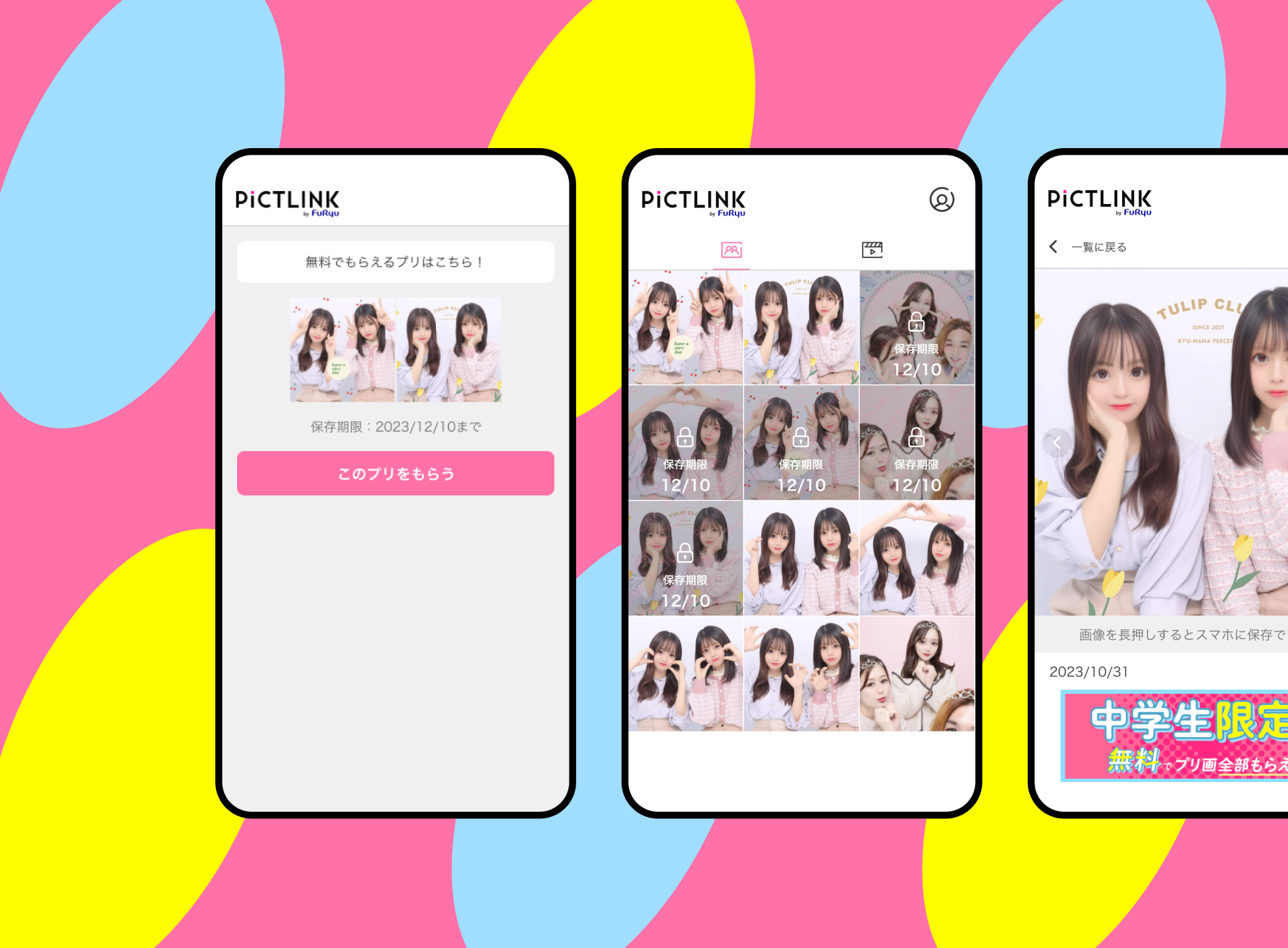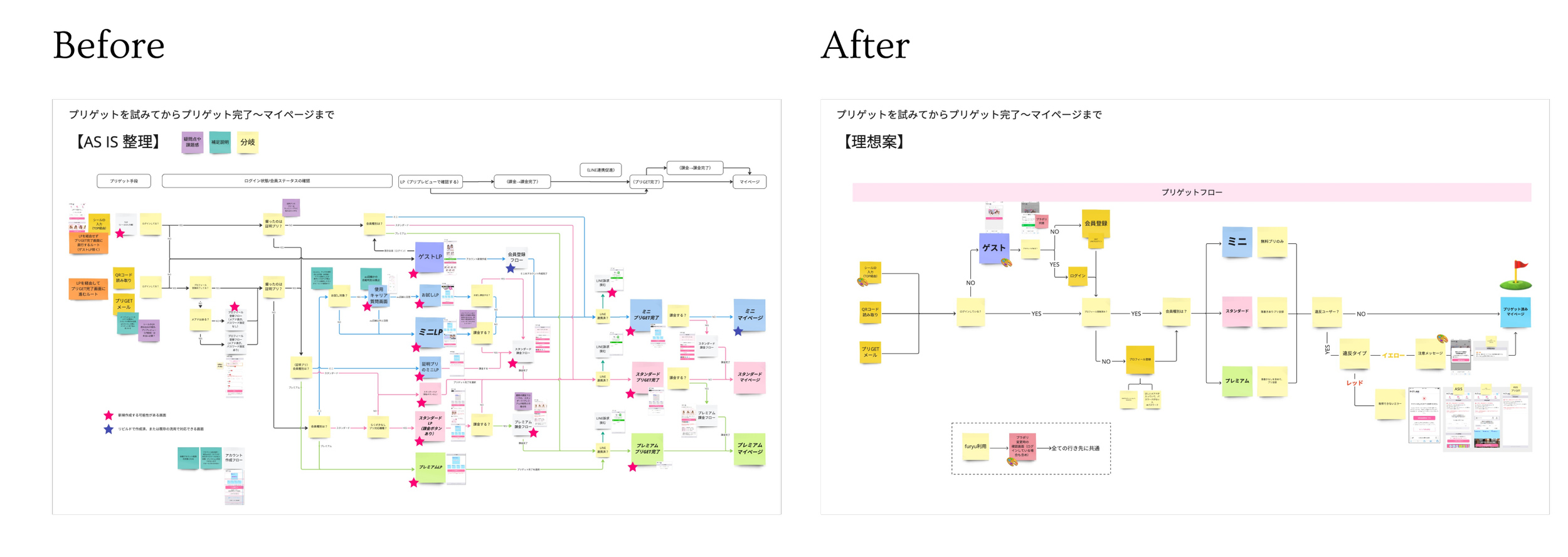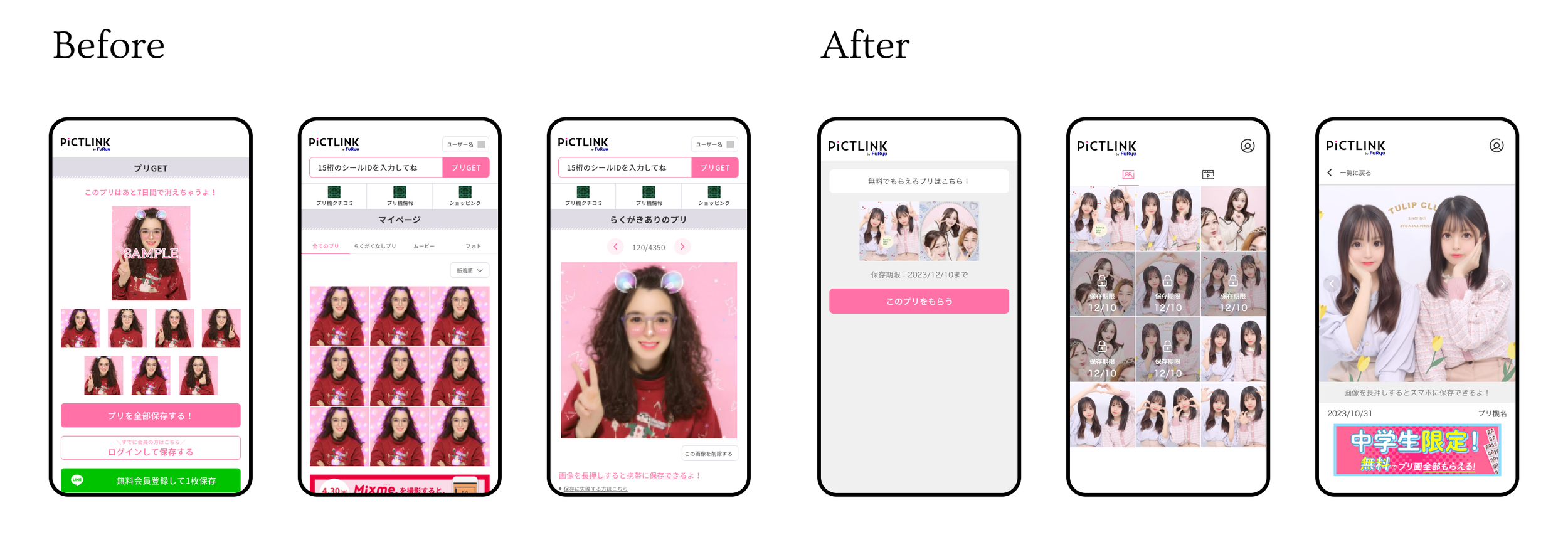PRODUCT DESIGN &
DESIGN MENTORING
2023 - 2024
PictLink
FuRyu Corporation (フリュー株式会社)
About
FuRyu and PiCTLink
FuRyu Corporation is a Japanese entertainment company based in Tokyo and Kyoto, Japan. Their businesses include publishing and development of video games, mobile games, photo-booths, figures and multimedia content。
PiCTLink are the website and app through which users can download digital copies of the photos (called ‘Puri (プリ)’ in Japanese) from the photo booth (called ‘Purikura(プリクラ)’ in Japanese). When a customer took photos at the photo booths (which commonly installed at game arcades in), they will get a printed stickers with selected photos. The service PiCTLINK allows users to download and manage the digital versions of their puri photos.
My Contributions
Research, ideation and discovery
Product design
Design mentoring
Workshop facilitation
Main Activities and Achievements
Product Design:
Improving conversion from QR code scanning to receiving Puri photos
Goals
The primary goal for the MVP was to boost the conversion rate from QR code scanning to receiving first Puri photos, and to encourage sign-ups for the free membership.
After kick-off, we organized a workshop with managers, researchers, and engineers from the client’s team. This brought everyone together to align on the product vision, review user research findings, and establish key hypotheses:
Simplifying the process for first-time users to collect free Puri photos would improve conversion rates.
Reducing information on each screen would make the content more readable for our target users (mainly primary and high school students).
Enhancing the Puri viewing experience would increase user engagement.
A strong free user experience could encourage more users to convert to the subscription membership for added services.
Based on these hypotheses, we focused on designing a smoother, distraction-free experience to improving the success rate of getting Puri photos for first-time users.
Approaches
Working closely with Product Owners, we outlined the main user stories and iterated updates in an agile format. Throughout the process, we aligned each update with business goals, ensuring the design changes would support—not disrupt—marketing and business strategies (e.g., access to campaigns).
My primary approaches included:
Visualizing the user journey across scenarios to spot repetitive processes and uncover opportunities for simplification.
Mapping out user flows to identify issues and clarify related screens.
Assisting Product Owners in prioritizing user stories to align with sprint goals.
Re-designing the process for primary user actions to ensure a smoother experience.
Re-structuring information hierarchy to reduce distractions within user flows.
Delivering design solutions based on the team’s agreed-upon approach.
Result
As a result, A/B testing demonstrated a notable improvement in conversion rates:
The success rate from scanning a QR code to receiving Puri photos increased by 3.2%.
Free membership registrations saw a 13.0% increase.
The conversion rate from free membership to paid subscriptions rose by 2.7%.
Design Mentor:
Fostered teamwork for individual growth and improved collaboration among design teams
Challenges
Throughout the project, I worked closely with designers, engineers, product owners, and client managers to transition their PictLink product team into a more agile workflow. The young engineers and designers on the client side were highly motivated to learn. By collaborating together, we successfully built a proactive product team that embraced change, demonstrated curiosity, and confidently worked as a cohesive unit to create great products.
In addition, I worked continuously with the design manager to improve the performance of the design team. Upon joining the project, I met with the design manager to discuss the challenges faced by the team, including:
Designers were unfamiliar with Figma.
Individual products were handled by 1-2 designers, but they lacked a shared design format, leading to inconsistent designs across products.
Junior designers struggled to find growth opportunities within the company.
User research findings, while valuable, often did not align with the product team’s priorities, creating frustration on both sides as critical issues were not adequately addressed.
Approaches
To address these challenges, I focused on creating an environment where designers from different teams could collaborate effectively and strengthening the connection between the research and design teams.
Key initiatives included:
Mentorship through Projects: I worked alongside junior designers in co-design activities, encouraged them to take ownership of their design tasks, and provided feedback by asking questions like “why” rather than simply giving answers.
Weekly Meetings: I organized regular meetings to check on everyone’s status, collect topics for discussion, and invite relevant people to share knowledge and experiences, fostering a culture of “team knowledge.”
Cross-Functional Collaboration: I encouraged designers to seek input and support from engineers and researchers, promoting co-creation and increased teamwork across different processes.
Workshops and Training: I conducted sessions on branding design, planning and sharing research findings with both research and design teams, improving research outputs and creating a shared understanding of processes.
Result
Over several months of collaboration, these practices led to a consistent and cohesive design system across the client’s product ecosystem. Designers gained more opportunities to share their opinions with other teams and receive direct feedback, further enhancing their growth.
As I prepared to leave the team to move to New Zealand, I focused on equipping the designers with the confidence and skills to lead projects independently. While there was still more to achieve, I am proud of the progress made before my departure.
One of the most meaningful moments during my time as a Design Mentor came when I received this feedback from a manager after the final group retrospective before I moved to New Zealand. This comment was sent to me as personal message, which is also why it is especially encouraging to me as a designer.
「今日の振り返り会。デザイナーという立場で、誰でもできる環境を考えていて、今まで出会ってきたデザイナーとの違いにびっくりでした。
デザイナーさんは良い意味で、ユーザーに響くデザインを誰よりも良い物をつくる!ってマインドでやっていると思ってました。だけど、ジクンさんのように誰でもできる、という観点を言えるデザイナーって本当にスキルがあるから言えることだなって感動しました。」
“During today’s reflection session, I was struck by how you, as a designer, think about creating an environment where anyone can contribute. It’s different from the other designers I’ve met before.
I had thought that designers, in a good way, were driven by the mindset of creating something that resonates with users better than anyone else could. But I was truly moved to hear someone like you, with real skills, express the idea of making design something anyone can do.”
Department Manager from FuRyu
Key Takeaways
Real solutions come from collective understanding in the business: Even when the problem and its cause seem obvious, translating it into actionable questions requires a deep understanding of the business, available resources, and constraints across all teams. Finding real solutions is a shared effort that benefits from collective thinking and collaboration.
Shared knowledge builds stronger teams: One of my focuses in this project was creating a shared foundation for how the design team works, from tools to processes to ways of giving feedback. This helped build trust, connect designers, and create a space where team members felt comfortable sharing and learning. Over time, this approach expanded to include the research team, which also improved cross-functional collaboration.
Guide people to a decision they would really need: In Japanese digital product culture, there’s a common pattern of layering features over time, often without removing or refining earlier ones. This can make it harder to keep user focus, which is a core principle of good UI design. In cases like this, rather than pushing back directly, I found it more effective to guide clients toward better decisions by showing the “why” behind design choices. Building mutual understanding led to better outcomes.





